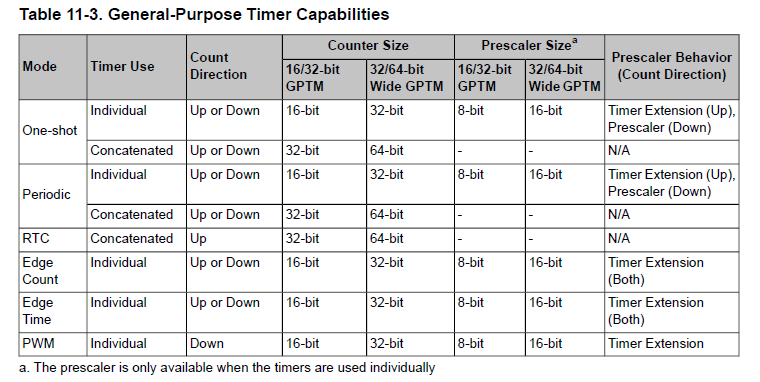Other Parts Discussed in Thread: EK-TM4C1294XL, TM4C1294NCPDT
Hello,
here is my code to configure timer0A as a capture compare PWM it works with only 16 bit operating modes, I just want to configure it with 32 bit operating mode:
void init_timer(void)
{
// Enable and configure Timer0 peripheral.
SysCtlPeripheralEnable(SYSCTL_PERIPH_TIMER0);
// Initialize timer A and B to count up in edge time mode
TimerConfigure(TIMER0_BASE, (TIMER_CFG_SPLIT_PAIR | TIMER_CFG_A_CAP_TIME));//when i'm trying to change TIMER_CFG_SPLIT_PAIR it doesn't work
// Timer a records pos edge time
TimerControlEvent(TIMER0_BASE, TIMER_A, TIMER_EVENT_POS_EDGE);
//configure timer to count all its width
TimerLoadSet(TIMER0_BASE, TIMER_A, 0xFFFF);//so when i putting(0xFFFFFFFF)it just loads (0xFFFF)
//Configure the pin that the timer reads from (PB6)
SysCtlPeripheralEnable(SYSCTL_PERIPH_GPIOB);
GPIOPinConfigure(GPIO_PB6_T0CCP0);
GPIOPinTypeTimer(GPIO_PORTB_BASE, GPIO_PIN_6);
// Registers a interrupt function to be called when timer b hits a neg edge event
IntRegister(INT_TIMER0A, ISR_Capture);//ISR_Capture is my ISR code
// Makes sure the interrupt is cleared
TimerIntClear(TIMER0_BASE, TIMER_CAPA_EVENT);
// Enable the indicated timer interrupt source.
TimerIntEnable(TIMER0_BASE, TIMER_CAPA_EVENT);
// The specified interrupt is enabled in the interrupt controller.
IntEnable(INT_TIMER0A);
}
So, what should i do or change to make the timer works with 32 bit as a capture compare unit?



